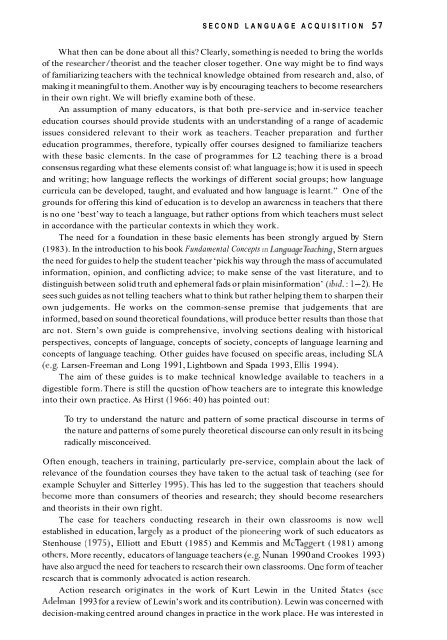English Language Teaching in its Social Context
English Language Teaching in its Social Context
English Language Teaching in its Social Context
Create successful ePaper yourself
Turn your PDF publications into a flip-book with our unique Google optimized e-Paper software.
SECOND LANGUAGE ACQUISITION 57What then can be done about all this? Clearly, someth<strong>in</strong>g is needed to br<strong>in</strong>g the worldsof the researcher/theorist and the teacher closer together. One way might be to f<strong>in</strong>d waysof familiariz<strong>in</strong>g teachers with the technical knowledge obta<strong>in</strong>ed from research and, also, ofmak<strong>in</strong>g it mean<strong>in</strong>gful to them. Another way is by encourag<strong>in</strong>g teachers to become researchers<strong>in</strong> their own right. We will briefly exam<strong>in</strong>e both of these.An assumption of many educators, is that both pre-service and <strong>in</strong>-service teachereducation courses should provide studcnts with an undcrstand<strong>in</strong>g of a range of academicissues considered relevant to their work as teachers. Teacher preparation and furthereducation programmes, therefore, typically offer courses designed to familiarize teacherswith these basic clemcnts. In the case of programmes for L2 teach<strong>in</strong>g there is a broadconscnsus regard<strong>in</strong>g what these elements consist of: what language is; how it is used <strong>in</strong> speechand writ<strong>in</strong>g; how language reflects the work<strong>in</strong>gs of different social groups; how languagecurricula can be developed, taught, and evaluated and how language is learnt.” One of thegrounds for offer<strong>in</strong>g this k<strong>in</strong>d of education is to develop an awarcncss <strong>in</strong> teachers that thereis no one ‘best’ way to teach a language, but rathcr options from which teachers must select<strong>in</strong> accordance with the particular contexts <strong>in</strong> which thcy work.The need for a foundation <strong>in</strong> these basic elements has been strongly argued by Stern(1 983). In the <strong>in</strong>troduction to his book Fundamental Concepts In <strong>Language</strong>Each<strong>in</strong>g, Stern arguesthe need for guides to help the student teacher ‘pick his way through the mass of accumulated<strong>in</strong>formation, op<strong>in</strong>ion, and conflict<strong>in</strong>g advice; to make sense of the vast literature, and todist<strong>in</strong>guish between solid truth and ephemeral fads or pla<strong>in</strong> mis<strong>in</strong>formation’ (Ibd : 1-2). Hesees such guides as not tell<strong>in</strong>g teachers what to th<strong>in</strong>k but rather help<strong>in</strong>g them to sharpen theirown judgements. He works on the common-sense premise that judgements that are<strong>in</strong>formed, based on sound theoretical foundations, will produce better results than those thatarc not. Stern’s own guide is comprehensive, <strong>in</strong>volv<strong>in</strong>g sections deal<strong>in</strong>g with historicalperspectives, concepts of language, concepts of society, concepts of language learn<strong>in</strong>g andconcepts of language teach<strong>in</strong>g. Other guides have focused on specific areas, <strong>in</strong>clud<strong>in</strong>g SLA(e.g. Larsen-Freeman and Long 1991, Lightbown and Spada 1993, Ellis 1994).The aim of these guides is to make technical knowledge available to teachers <strong>in</strong> adigestible form. There is still the qucstion of’ how teachers are to <strong>in</strong>tegrate this knowledge<strong>in</strong>to their own practice. As Hirst (1 966: 40) has po<strong>in</strong>ted out:To try to understand the nature and pattern of some practical discourse <strong>in</strong> terms ofthe nature and patterns of some purely theoretical discourse can only result <strong>in</strong> <strong>its</strong> be<strong>in</strong>gradically misconceived.Often enough, teachers <strong>in</strong> tra<strong>in</strong><strong>in</strong>g, particularly pre-service, compla<strong>in</strong> about the lack ofrelevance of the foundation courses they have taken to the actual task of teach<strong>in</strong>g (see forexample Schuyler and Sitterley 1995).This has led to the suggestion that teachers shouldbecome more than consumers of theories and research; they should become researchersand theorists <strong>in</strong> their own right.The case for teachers conduct<strong>in</strong>g research <strong>in</strong> their own classrooms is now wellestablished <strong>in</strong> education, largcly as a product of the pioncer<strong>in</strong>g work of such educators asStenhouse (1975), Elliott and Ebutt (1985) and Kemmis and McTaggert (1981) amongothcrs. More recently, educators of language teachers (e.g. Nunan 1990 and Crookes 1993)have also argued the need for teachers to rcscarch their own classrooms. Onc form of teacherrcscarch that is commonly advocatcd is action research.Action research orig<strong>in</strong>ates <strong>in</strong> the work of Kurt Lew<strong>in</strong> <strong>in</strong> the United Statcs (sccAdelman 1993 for a review of Lew<strong>in</strong>’s work and <strong>its</strong> contribution). Lew<strong>in</strong> was concerned withdecision-mak<strong>in</strong>g centred around changes <strong>in</strong> practice <strong>in</strong> the work place. He was <strong>in</strong>terested <strong>in</strong>












